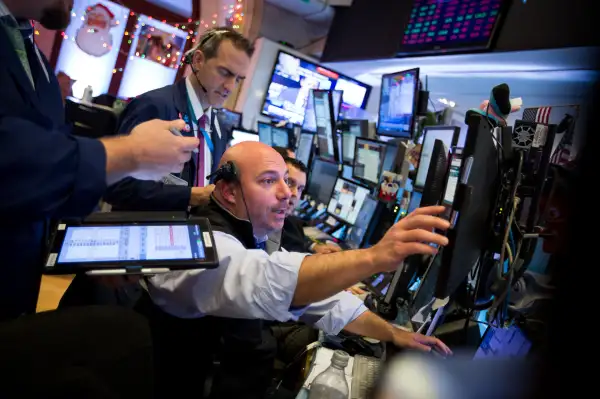The Stock Market Has Been Stuck for Weeks. Here Are 5 Signs It Could Get Worse
Money is not a client of any investment adviser featured on this page. The information provided on this page is for educational purposes only and is not intended as investment advice. Money does not offer advisory services.

The once-red-hot stock market is starting to cool down. In fact, the Dow Jones industrial average has pretty much gone nowhere since the end of October and has fallen nearly 300 points over the past week.
But do investors have more to worry about than just slowing returns? The following five indicators point to a stock market facing real troubles — and a potential downturn ahead.
1. Junk Bonds Are Flashing a Warning Sign
Bond investors are often ahead of the curve — and ahead of stock investors — when it comes to spotting risks in the economy and market. That's because bonds tend to return far less than equities do over time, so there's less room for error.
Right now, one particular type of bonds — namely, junk bonds, which are issued by companies with less-than-pristine balance sheets — is signaling trouble ahead.
Since the end of September, junk bonds have begun to lose value, with the broad high-yield junk bond market down more than 2%, according to Morningstar. That may not sound like much, but junk bonds and stocks usually move in tandem, because these low-quality bonds are saddled with stock-like risks. And slumping junk bonds returns have historically foreshadowed troubles for equities.
In 2007, for instance, before the start of the most recent bear market, junk bonds began to slump more than four months before equities did. Similarly, junk bonds started to lose ground in December 1999, three months before the dotcom bubble burst and the 2000-2002 bear market began.
2. The Market Is Literally Running on Fumes
"The juice fueling this bull market may finally be running low," says Jim Paulsen, chief investment strategist for The Leuthold Group.
Paulsen is referring to a technical measure known as "financial market liquidity," or the supply of money sloshing around the economy over and above what's needed to finance normal business activity. This is what greases the wheels of the stock market.
Since this bull market began in March 2009, the annualized growth rate for cash and checking deposits plus savings held in money market securities and mutual funds has been 6%, versus 3.6% for nominal GDP growth.
In other words, "the financial markets have been ‘juiced’ by persistent liquidity growth of 2.4% per annum," Paulsen says.
However, in the last six months, financial liquidity has actually contracted mildly, he points out — "signaling the foundation under investors’ feet may be turning to sand."
This is only the the third time during the current economic recovery that financial liquidity has contracted. The other two occasions took place in 2010, right before the S&P 500 index suffered a 16% downturn, and in the summer of 2014, just before the S&P 500 fell nearly 8%.
3. Valuations Are Beyond Worrisome
The price/earnings ratio for the broad U.S. stock market, based on 10 years of averaged profits, now stands at 31.3. That's roughly 20% higher than the market's valuation in October 2007, at the start of the 2007-2009 bear, and 10% more expensive than at the start of the Great Depression.
"Based on the consensus of the most historically reliable market valuation measures we identify, the U.S. equity market is now at the most offensive level of overvaluation in history, exceeding even the levels observed in 1929 and 2000," noted prominent market strategist and historian John Hussman in his most recent blog post.
Hussman concedes that it's impossible to know when the markets will fall from the weight of overvaluation — it could take months.
However, "we expect the market to lose nearly two-thirds of its value by the completion of this cycle, while still posting negative total returns over the next 10-12 years."
He adds: "In my view, Wall Street is completely out of its gourd."
4. Small Stocks Are Lagging Badly
Small-company stocks have started to lose ground over the past six weeks, and that's not a good sign.
Shares of small companies — which tend to be faster-growing but more speculative than industry-leading titans — are widely regarded as canaries in the coal mine for the stock market. Historically, they tend to outperform blue chip stocks at the start of new bull markets, and they lag large-company shares at the tail end of old rallies.
So how are they doing now? Well, since the start of October, the Russell 2000 index of small-company stocks has fallen nearly 3%, while the Dow Jones industrial average is up nearly 3%.
For the year, small stocks are now trailing blue chip shares by more than 10 percentage points. That, too, is a bad omen. Five of the past six bear markets were preceded by years in which small-company stocks trailed large stocks by double digits.
5. Stock Market Exuberance Isn't Waning at All
A just-released survey of fund managers by Bank of America Merrill Lynch found something interesting: A record high 48% of investors think equities, broadly, are overvalued. Yet those same fund managers are allocating more money to global equities than at anytime since 2015 — and less money to cash (that is, a safe haven) than at any time since 2013.
Meanwhile, a record high percentage of investors say they are taking on more risk than they normally do.
What does this mean? “Icarus is flying ever closer to the sun, and investors’ risk-taking has hit an all-time high," says Michael Hartnett, chief investment strategist.
He adds: "A record high percentage of investors say equities are overvalued yet cash levels are simultaneously falling — an indicator of irrational exuberance.”
Of course, irrational panic isn't good either. You don't want to overreact and undo your entire portfolio out of fear.
Instead, carefully consider your own situation, as Money columnist John Waggoner recently pointed out.
For instance, if you haven't reset your mix of stocks and bonds back to appropriate weightings in a while, do that now. By selling some winning stocks in your portfolio and using that money to replenish your bonds, you'll lower your overall risk.
What's more, you don't even have to shift out of stocks to reduce risk. You can simply emphasize unloved and overlooked shares over high-flying expensive stocks. Overlooked "value stocks" have less room to fall if a downturn is lurking around the corner.
